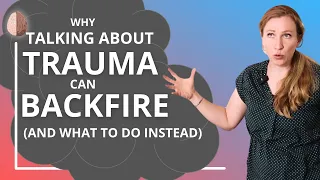In this article, you’ll learn how to create a greenhouse where your kids can grow and experience emotional safety.
The goal of a greenhouse is not to protect plants or simply to keep plants safe, the goal of a greenhouse is to create a space where plants can grow up to be functional, healthy, and productive outdoors. One thing most people don’t know about greenhouses is that they don’t simply keep the plant comfortable, a good greenhouse actually has all sorts of features that gradually introduce the seedlings to challenges – fans, temperature changes, pot changes, and gradually introducing the plants to more and more difficult conditions.
How to Deal with Anxiety in Children
Your job as a parent is not to protect your child from anxiety, but to help them learn to be resilient so that they can be functional and healthy humans. To learn the skills to manage emotions and make good choices, not to just try to make anxiety go away.
In the last video we talked about the foundation of your greenhouse- your mindset. When you learn how to change your fundamental approach to anxiety, you can create a space for your kids to change their relationship to anxiety – so that they can be healthy, resilient, self-assured and functional.
To summarize part one: Kids look to parents to know how to respond to anxiety. Anxiety is not bad, and it’s not something that has to be eliminated. No kid is going to grow up and never have anxiety again because their parents did everything perfectly. Instead parents can teach their kids how to relate to anxiety. Avoiding anxiety and triggers actually makes anxiety worse, not better. And a more helpful mindset is “It’s ok to feel anxious, but we still choose our actions”. This is the foundation for growth.
So now let’s talk about laying the foundation for your kid’s success.
Physical And Emotional Safety is Essential
Physical and Emotional safety are like the protective cover of your greenhouse. This series on helping your child with anxiety depends on your child being actually safe. They aren’t being mistreated, abused, attacked, they have food to eat and a bed to sleep in, and parents who love them. You don’t have to be perfect, but if your child is anxious and being abused- verbal, physical, emotional or sexual abuse- their anxiety is actually quite functional- it’s sending a message that you need to help them be safe, not just make them feel safe when they’re in danger. So if food, shelter, and safety are an issue, make sure to focus on creating that foundation first.
But the really cool thing about humans is that we can face a lot of challenges, difficulties, trauma or hardship if we just have one thing.
2 Things that Break Emotional Safety - Shame and Rescuing
The number one thing that creates emotional safety is connection. Your relationship with them is like the protective cover of a greenhouse, it creates the environment where growth is possible. Just like a tiny seedling, your child was helpless as an infant and depended on you 100% for their safety and survival. Children are hardwired to seek connection with their parents and they rely on that connection to determine if they feel safe or fearful. Your connection provides warmth while they face challenges and grow.
So the most important thing you can do is show them that you can be connected, even when they’re having big emotions, like fear. There are two big mistakes parents make when trying to help their child with anxiety: Shaming them or Rescuing them.
- When a child seems anxious about something that feels small to us, we sometimes have a gut reaction to say “Oh come on, Just get over it. look on the bright side” This essentially says “Stop feeling that way. Don’t feel anxious or I will disapprove of you. “Why are you making such a big deal of this, it’s only school” Trying to make your child not feel anxious is shaming them. The first thing this does is put your child in an impossible situation- telling them they shouldn’t be feeling what they are feeling. And the second thing is it breaks the safe connection with shame- it essentially communicates “Something about you is bad and you need to stop for me to like you”. It’s like pushing the plant out of the protective cover of the greenhouse and letting them get burned from frost.
- The second common mistake parents make is Rescuing their child from anxiety. “If sleeping alone makes you anxious, I’ll sleep with you.” “If giving a presentation makes you anxious, I’ll talk to your teacher and see if you can do an essay instead”. As parents, we want to protect our kids. But in these situations, we’re not protecting them from harm, but from feeling something. This sends the message that they can’t actually handle the challenge in front of them. It says “My parent is scared of this feeling too”. Your behaviors communicate to them that you don’t believe they’re capable of facing a challenge and that makes them trust themselves less. And not only are you showing them that they can’t handle the outward challenge, you’re also communicating that the feeling of anxiety is dangerous. Now there are times when kids aren’t capable of facing a threat- toddlers shouldn’t be playing in the road by themselves. Right? 4-year-olds generally shouldn’t be traveling solo through a big city. But as parents, you discern between actual threats and stuff that feels scary but is actually safe- like giving a presentation at school, talking with a teacher about a problem they’re having, attending preschool, and getting a vaccine.
You Create Emotional Safety by Connecting With Your Kids While They Have Feelings
Now don’t blame or shame yourself for having done either of these things, it’s normal for parents to do both, and no, you probably haven’t ruined your kids, kids are super resilient, super adaptable. And just like them, you can grow and change too.
So instead of shaming them for having feelings or rescuing them from their feelings, your job is to connect with them while they have feelings. It’s not your job to make your kid not feel something. To not feel nervous, to ensure they feel happy. You’re not responsible for changing how they feel. Your job is to walk with them on their journey to build a belief in themselves that they can face the challenges that come their way. Say something like “Hmm I’m here, we’ll figure this out”. Your job is to bring your presence- which communicates safety- to an uncertain situation. Kids don’t remember what they were anxious about, they remember what their parents did with it. So your loving presence communicates that even in the face of a scary situation or big intense emotions, that you’ll be there for them no matter what, that you trust them to find their way through, and that it’s all going to be ok.
So if the only thing you do for your kids is to show them that the two of you can face emotions together, you’re doing a lot to create an environment where your kid can learn how to relate to anxiety. Resist the urge to protect and comfort your kids and instead join them in their process.
So if your kid is worried about his parents leaving him at night- you might have a tendency to say “It’s not a big deal. Don’t be scared” that’s not super helpful. You can’t just un-feel a feeling. Instead you could say something like “When you go to bed, you have a big worry that you’ll be alone. That’s a scary thought. Thanks so much for telling me.” “I wonder what we could tell that thought?”
The words you say aren’t as important as your presence. The real strategy is connection– we show our kid that even when they’re nervous, we are here for them and we can sit with that fear together. And even when the time comes for you to leave, you tell them “I know you can face this. I’ll check in on you in a few minutes to see how you’re doing it.”
By connecting with them, you bring a sense of rock-solid safety to any situation. This is your protective cover. Then when you’ve got this solid relationship, you can help your child face their fears. Here’s a few things you could say to show them you care:
You look uncertain, can you tell me about that?
It’s okay to feel anxious. It’s a normal feeling.
“I’m here for you and I’ll help you through this.”
“Let’s take a deep breath together and work through this.”
“We can come up with a plan to help you face this.”
“I love you no matter what and we’ll get through this together.”
Sometimes people think that if you validate an emotion- that means you also have to let your child escape that emotion. If going to school makes you anxious and you validate that, then you don’t make your child go to school. If sleeping in their own bed scares them, you have to protect them by letting them sleep with you. But that’s not what validation is at all, it’s just saying “I can feel what you’re feeling” It’s empathy. But your action doesn’t have to be rescuing, it can be connecting and challenging them too.
Use AND When You Validate
We can be nervous AND breathe
You can cry at drop off, and still go into the school
You can feel worried and still go down the slide
It’s ok to feel worried. I feel that way too sometimes.
A lot of emotions just need to be seen, and then they resolve themselves because they’ve delivered their message. A lot of kids just want to be seen too. Your presence is more powerful than rescuing them. As you help them face their fears with your constant and loving support, they will get stronger and more resilient over time.
Click on the link below to check out the FREE Grounding Skills for Anxiety course.




